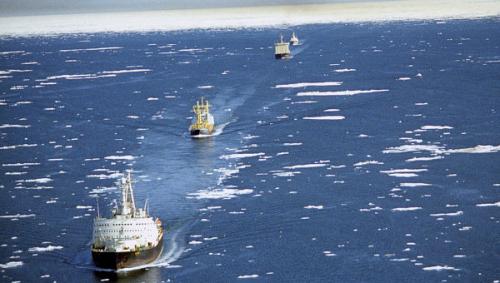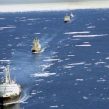
Russia’s Arctic Project Moves Forward but Epitomizes Russia’s Economic and Defense Problems
Publication: Eurasia Daily Monitor Volume: 9 Issue: 156
By:

For several years, Russia has been telling the world about how it will build up its commercial, energy and military position in the Arctic. Recently, it appears to have begun the actual implementation of those linked projects. Thus, President Putin has nominated Federation Council member Artur Chilingarov, the explorer who first claimed the Arctic region for Russia in 2007, as Russia’s special envoy for international cooperation in the Arctic and Antarctic (Interfax, August 3). Speaking to the venerable Russian Geographic Society, Putin also announced two other projects of major commercial and scientific importance in the Arctic. The first, after 18 months of studies, is the start of an environmental clean up on the Franz Josef Land Archipelago in the Arctic. And the second is the creation of the Arctic Floating University research and education expedition, which is already gathering climactic data to produce more accurate weather forecasts (www.kremlin.ru, August 6).
Of course, Russia’s interest is not purely scientific. Numerous Russian officials have long claimed that the Arctic is a mineralogical and hydrocarbon treasure house and the basis of Russia’s future energy programs. But for Russia to unlock these treasures lying in the Arctic and off its continental shelf, formidable political obstacles, not to mention environmental obstacles, must first be removed. And here the Russian government is still unable to move. Deputy Prime Minister Arkady Dvorkovich admitted that the issue of granting private companies access to the shelf has not yet been resolved (Interfax, August 2). Obviously the same holds true for foreign companies. Not surprisingly, commitments by companies who are financing the existing investments are “insufficient,” according to Dvorkovich, who has now been tasked with devising tax and customs incentives for companies who want to develop Arctic hydrocarbon reserves. Yet, the Ministry of Natural Resources and Environment wants to retain the tax status quo that effectively bars anyone but Rosneft and Gazprom from exploring there. Indeed, private Russian firms like Lukoil, Bashneft, Surgutneftgaz and TNK BP are still excluded from Arctic exploration (Moscow Times Online, August 3).
Although foreign firms like Total of France, Statoil of Norway and Italy’s ENI have been invited into Arctic oil and gas projects, this is not working out too well either. In July, Statoil withdrew from the Shtokman field joint venture, forfeiting $336 million and its 24-percent stake in the project (see EDM, August 10). This project, where Gazprom holds 51 percent and Total a further 25 percent, has been unable to come up with an investment agreement of $15 billion for the opening stage of the project (Reuters, August 7). In departing, Statoil said, “We have made it quite clear that we need to see considerable improvement in fiscal terms and conditions in order to move forward on Shtokman” (Wall Street Journal, August 7). So it is not surprising that Russian Prime Minister Dmitry Medvedev decried that the entire Arctic development plan is threatened by “infrastructure imperfection,” unresolved social issues and improper financing or the complete lack thereof. Yet, he refuses to allocate more federal subsidies and wants more private sector participation even though he will oppose any diminution of state control over the issuance of licenses and the supervision of them. Meanwhile the tax structure still inhibits foreign and private investment. Therefore Russia’s plans to quintuple annual oil production from 13 million tons to 66.2 million tons is going nowhere as is the plan to go from 57 billion cubic meters (bcm) to 230 bcm (billion cubic meters) of continental shelf gas (Rossiya 24, August 2). It can thus be seen that the economics of the development of the Arctic epitomize many of the dilemmas inherent in Russian economic policy as a whole.
But that has not deterred military expansion there. Putin has promised to build new naval bases in the Arctic, as well as bases for the Border Guards (Russia Today, August 6). Security Council Secretary Nikolai Patrushev also announced that a list of naval infrastructure hubs along the Northern Sea route – which Russia claims as its own, a claim disputed by everyone else – has been drawn up to serve as resupply bases for those Russian warships and border guard vessels patrolling along the country’s northern coast. And by 2020 there will also be coastal guard forces to safeguard the government’s Arctic interests (The Hindu, August 8; RIA Novosti, August 6). The Northern Fleet will also remain a primary strategic fleet (i.e. nuclear capable) along with the Pacific Fleet. Thus, Russia’s first two Borey-class strategic submarines with nuclear missiles will initially be deployed to the Northern Fleet and then to the Pacific Fleet, once the requisite infrastructure is established (RIA Novosti, August 8). This deployment not only heightens the strategic value of the Arctic and control thereof, it also points to Russia’s growing sense of a rising threat in the Asia-Pacific theater – and not only from the United States, but also China. Second, it suggests the outlines of a potential swing fleet strategy between the Northern and Pacific Fleets and the Arctic and Pacific Oceans.
These trends highlight both the importance of the Arctic to Russia and its threat perceptions. In the past, and maybe in the present as well, NATO remains the primary threat – not least to Russian energy facilities – for Russia’s military planners. However, it is also clear that China, which among other issues disputes Moscow’s claims to the Arctic, is already rising in Russian eyes as a potential future threat. Thus, trends in both commercial and military development of the Arctic offer a window on some of the most critical problems facing Russia today.




